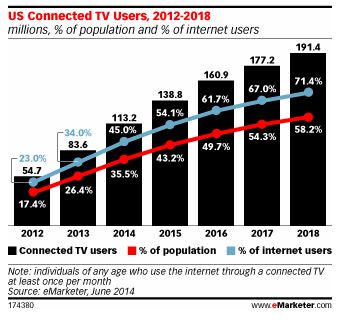This past week, MogoARTS held a session at Google’s San Francisco office on building a better marketing strategy using programmatic TV for our clients and partners.
We have all been witness to the massive shift from traditional media consumption to digital alternatives. The last bastion of this has long been TV, where eyes have been glued, but that is all changing now. This change is putting consumers in control of how they consume TV content, as well as creating exciting opportunities for marketers to reach these consumers in ways we could have never imagined.
Do you Hulu? Or do you Netflix? Maybe you have Amazon Video too. Have you heard about YouTubeTV? Maybe you have an AppleTV, Sling, or Roku? Or perhaps an Amazon Firestick or a Google Chromecast plugged into your TV? I just returned from a marketing conference in Florida and the first channel options on my hotel room TV included Hulu, Youtube, Netflix & Crackle.
 All of these choices enable consumers to watch wherever and however we want, paving the way for the “cord-cutting” trend. According to the Wall St Journal, more than one million consumers canceled their cable or satellite subscriptions in the second quarter of 2018. Some reading this right now are likely “cord-nevers,” as they have never had cable TV and never will. We are time-shifting our watching habits to mesh with our busy lifestyles and, when our schedule permits, binge watching too. According to Nielsen, in 2017 59% of American households had a streaming video subscription compared to just 38% in 2015. Additionally, eMarketer reports that the total population of US connected TV users has increased by 40.8% from 2012-2018.
All of these choices enable consumers to watch wherever and however we want, paving the way for the “cord-cutting” trend. According to the Wall St Journal, more than one million consumers canceled their cable or satellite subscriptions in the second quarter of 2018. Some reading this right now are likely “cord-nevers,” as they have never had cable TV and never will. We are time-shifting our watching habits to mesh with our busy lifestyles and, when our schedule permits, binge watching too. According to Nielsen, in 2017 59% of American households had a streaming video subscription compared to just 38% in 2015. Additionally, eMarketer reports that the total population of US connected TV users has increased by 40.8% from 2012-2018.
This change has been amazing for consumers and a nightmare for marketers trying to reach audiences with traditional TV. The original promise of TV involved large audiences watching scheduled programming. With limited choices, consumers flocked to their living rooms to watch scheduled television programming. It was an easy way for marketers to reach us. Now, TV as we know it will never be the same, and for TV advertisers, this choice has made us harder to reach than ever before.
Programmatic TV, a technology-automated and data-driven method of buying and delivering ads against TV content, is growing rapidly as cord-cutting dominates. Similar to how we operate in other digital channels, Programmatic TV allows us to use advanced data and automated technology while remaining device-agnostic to reach audiences wherever they choose to watch. We can reach audiences on their favorite channels like NBC, CBS, CNN, Food Network and more.
There are so many benefits of programmatic TV. You can take an end-to-end view of your campaigns, leverage all of your digital data, sequence ads to tell a story, and even use remarketing. At MogoARTS, we are fortunate to have a great relationship with our Google Marketing Platform for Enterprise team and access to some of the most advanced online advertising tools available, including programmatic TV.
With over 50 MogoARTS clients and partners joining us at the event and via Google Hangouts, there was much buzz and excitement around implementing programmatic TV. It was an especially exciting milestone for Mogo, bringing us full circle to where we started. We began in 2001 as a TV/Radio buying agency, launching Slingbox, helping eBay grow and helping introduce breakfast at Jamba Juice in the US. While we still have a broadcast buying team, we recognize that not all clients have the high budgets required to be successful with TV advertising; that’s initially what gave us our early start in digital early–and now, in a way, digital is bringing us back to TV.
With Programmatic TV, the future of TV is bright.
